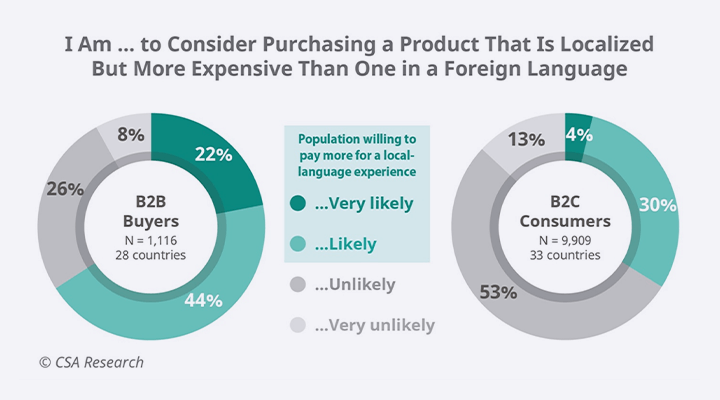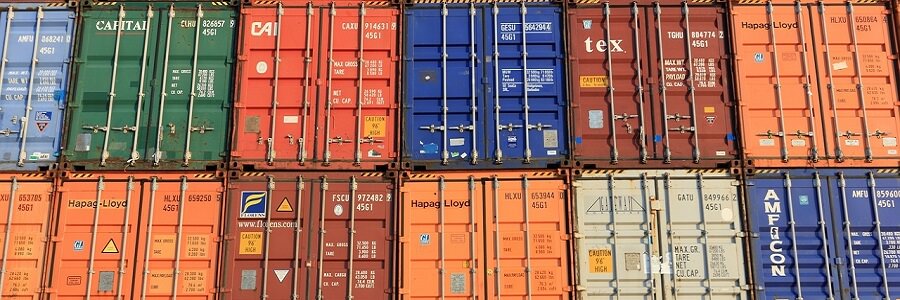
“Our customers all speak English. That’s why we save ourselves the trouble of translating into other languages.” If you share this opinion, you’re giving away enormous potential that you probably don’t even know exists.
A few years ago, I found this out myself. The website content and catalogs of a global market leader from the UK were available exclusively in English. This was good for the German competitor at which I worked: we were the clear market leader in the German-speaking countries while the world’s market leader was all but invisible to potential customers in Germany, Austria and Switzerland.
That’s because buyers tend to search in their native languages first. And that’s why the global market leader lost out with English-only content. People in Germany don’t search for “pleated filter” when they want to buy a “Faltenfilter”.
This happened 20 years ago. These days, most companies know that multilingual websites are a MUST to attract new customers.
Do companies act on this knowledge? I’ll explore the question in this blog post. This much for now: the results will leave you speechless.
Content
▶ Why is a multilingual website so important?
▶ Multilingual website: 22% more sales leads through localized content
▶ Multilingual websites: What’s the situation for analytical, biotechnology and lab technology companies?
▶ What’s keeping companies from setting up multilingual websites?
▶ How can companies attract customers in their native language with minimal effort?
▶ The bottom line: Multilingual content is key to gaining international customers
Why is a multilingual website so important?
Finn, a German, is planning the stag night for a friend. He is looking for a great location. Amsterdam is supposed to have top offers.
“I’ll do a quick search on Google,” Finn thinks to himself. He enters “Junggesellenabschied Amsterdam” in the search field and finds what he’s looking for right on the first page. The website junggesellenabschied-ideen.info offers all they need for an unforgettable evening.
Both Finn and the service provider are satisfied. Finn has found something suitable fast and the service provider’s top Google placement has generated a new customer.
But what about the service provider bachelorpartyamsterdam.de? This Dutch provider offers much more, and at lower costs. The website is also listed on page 1 on Google with a German-language version, but unfortunately only for the search term “Bachelor Party Amsterdam”.
So this provider misses out on all potential customers from German-speaking countries who search using the German term “Junggesellenabschied Amsterdam”.
You may think this example is a bit far-fetched. Well, I can also give you examples from the B2B sector:
German search term | English search term | French search term |
Exktraktionshülse | Extraction thimble | cartouche d'extraction |
Becherglas | Beaker | Bécher |
Stickstoffbestimmung | Nitrogen determination | Détermination de l'azote dans l'urée |
Tiefkühlschrank | Freezer | Appareils de thermorégulation |
Tiefkühlschrank | Quartz glass cuvette | Cuvette en verre quartz |
Analysenwaage | Analytical balance | Balance analytique |
French-speaking customers will search Google for “balance analytique” but not “analytical balance”. What does this mean for companies that do not have a multilingual website? They’re invisible to many potential customers! This is because we tend to search more in our native language. Only when we don’t find what we’re looking for, do we try in English.
Multilingual website: 22% more sales leads through localized content
At two companies, I pushed the development of multilingual websites. The results were impressive: With each additional language, we increased the number of sales leads by a factor of 3 to 5. For example, while we had been getting only 4 sales leads from Italy, we gained 21 sales leads after launching the Italian language pages.
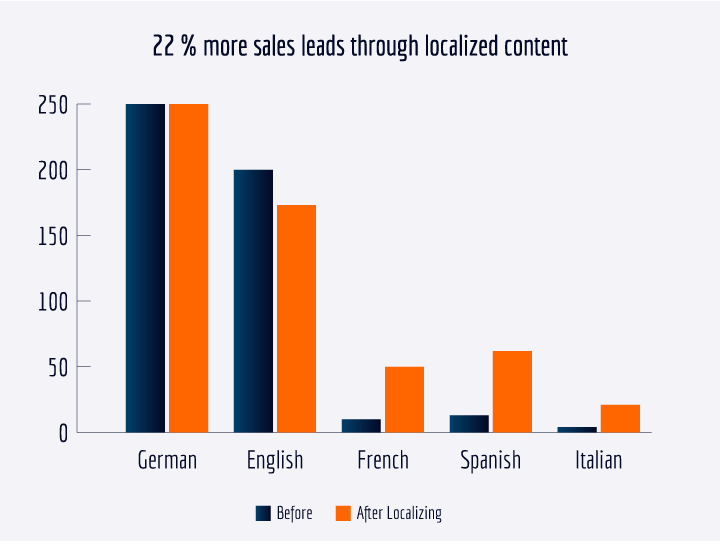
Companies gain new customers through multilingual websites
The buying experience is also influenced by language. According to a study by CSA Research, over 60% of B2B customers are willing to spend more money if a product is described in their native language.
Multilingual websites: What’s the situation for analytical, biotechnology and lab technology companies?
Have multilingual websites become commonplace or are they still rare? To find out, I analyzed 100 websites of SPECTARIS member companies in the analytical, bio and lab technology branch of this trade association.
These companies are export-driven and therefore active worldwide. My expectation: 80 percent of them would offer content in at least four languages on their website. How wrong I was! An unbelievable 47% of the websites are either monolingual or bilingual.
So these companies and their products are largely invisible to potential customers whose native language is neither German nor English.
Analyzing the websites revealed two extremes at the fringes of the spectrum:
1. The Mettler-Toledo website is available in 26 languages. This means that the company reaches almost all potential customers worldwide.
2. The DWK Life Sciences website is available only in English. So the company’s products can only be found using English-language search terms at Google.
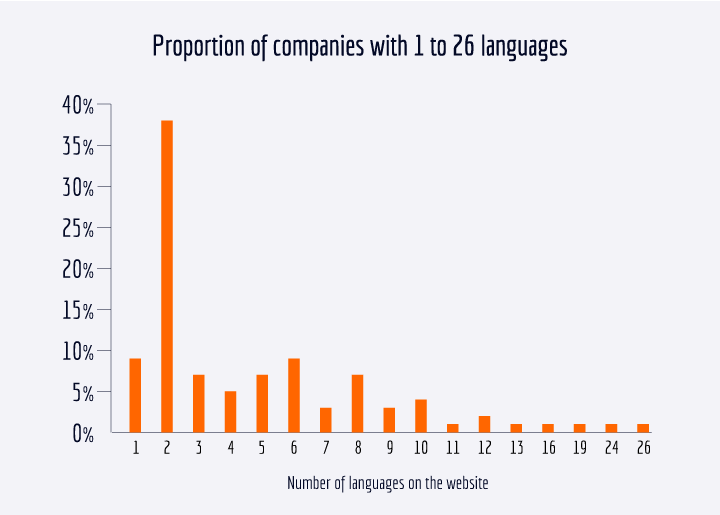
Multilingual websites – only 7% of investigated companies describe their products in more than 10 languages.
With its 414 million native speakers, Spanish is the second most common native language worldwide. This is in stark contrast to companies’ websites: only 40% of those surveyed host Spanish content.
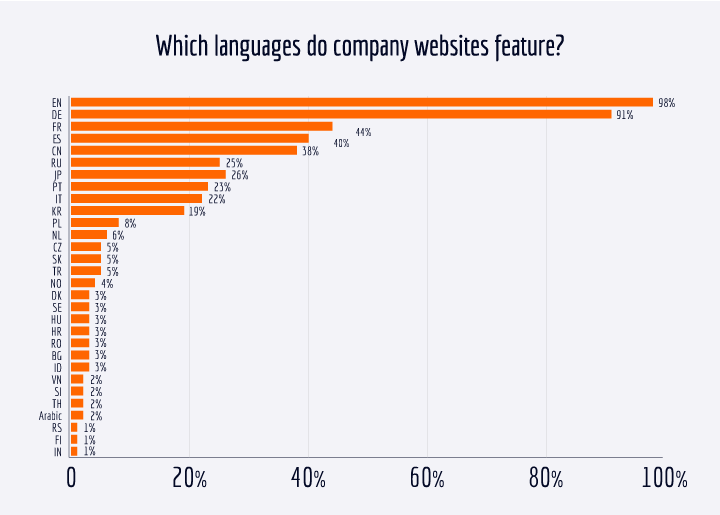
Only 40% of websites describe products in Spanish
What’s keeping companies from setting up multilingual websites?
The facts speak for themselves: multilingual websites make companies visible to potential customers worldwide and increase their sales.
So why are almost half the websites only bilingual? There are at least five reasons:
- Management is convinced that all buyers understand English. That’s why they save themselves the trouble of translating into other languages and deliberately don’t create multilingual websites.
- Companies shy away from the expense of the needed professional translations, especially when it comes to complex websites with hundreds of pages.
- Marketing and sales managers don’t know how effective multilingual websites are at increasing the visibility of their company.
- Decision makers massively overestimate the visibility of their own company.
- The content management system in use does not support multilingual websites.
How can companies attract customers in their native language with minimal effort?
Convincing management and securing the budget to translate and host content in multiple languages is hardly possible from one day to the next. It’s more promising to demonstrate and prove the effectiveness of multilingual content.
Example 1: E-mail marketing
I often receive marketing emails in German, but the call-to-action then leads me to an English language website because the provider doesn’t host it in German.
Tip: Use dedicated landing pages outside your website. You can create these in any language with Unbounce, for example, or have them created by a service provider.
This will let you receive more inquiries and thus give you strong arguments to be allowed to create multilingual websites in the future.
Example 2: A Company Presentation on a specialist industry portal
In online business directories with a wide reach, for example chemeurope.com, the leading portal for the chemical industry and its suppliers, B2B companies and what they offer are visible around the clock in four languages via a Company Presentation.
A Company Presentation introduces users to your company. It makes your range of products and services easy to find when searching in English, German, French or Spanish, thanks to diligent, structured keywording.
A Company Presentation lets you gain sales leads from all over the world, proving that multilingual content is worthwhile.
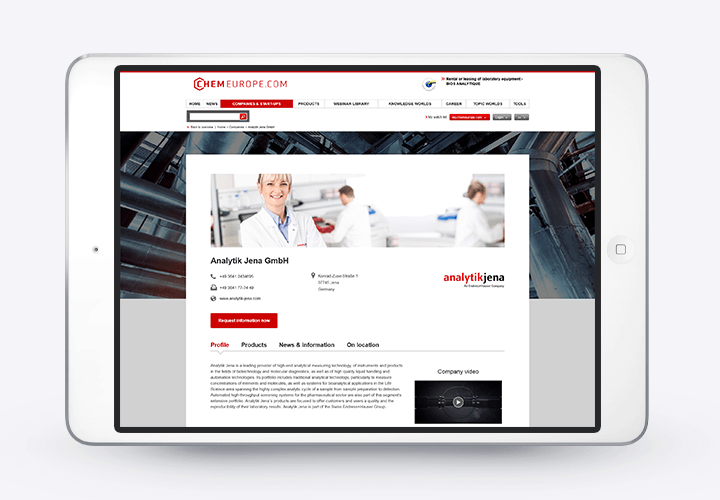
A comprehensive Company Presentation addresses users in English, French, German and Spanish.
Example 3: Presenting products on a specialist industry portal
Your company earns money with products. That’s why every sales lead gained at reasonable cost is important. If you present your products in several languages on specialist portals, you’ll gain new customers worldwide who search in their native language for a product they need.
Sales leads help to prove that multilingual content is worth the money you invest.
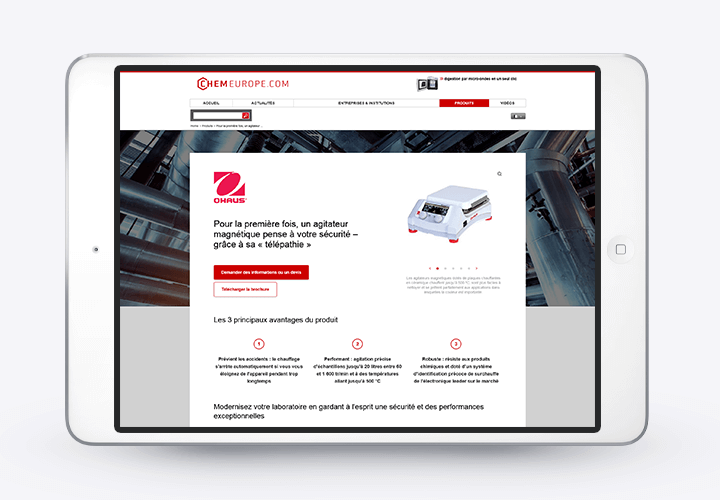
Gain new customers with a French-language Product Presentation.
Tip: Focus on the most important product groups and present one product from each group. This will save you money, and you’ll also gain the experience to optimize further measures effectively.
Example 4: Presenting whitepapers on a specialist portal
If visitors can download English-language whitepapers from your website, this will help you reach professionals
- who know your company and go directly to the website
- who have searched for the topic in English.
But what about those who don’t know your company and whose first language isn’t English? Simply present your whitepaper on specialist industry portals in several languages. This lets you reach potential customers from all over the world.
By the way, you don’t need to translate the whitepaper itself into multiple languages. It’s all about being found. What you need is just a short content description in the native language of your target groups. This lets your whitepaper be found via a search on Google or on the specialist portal itself.
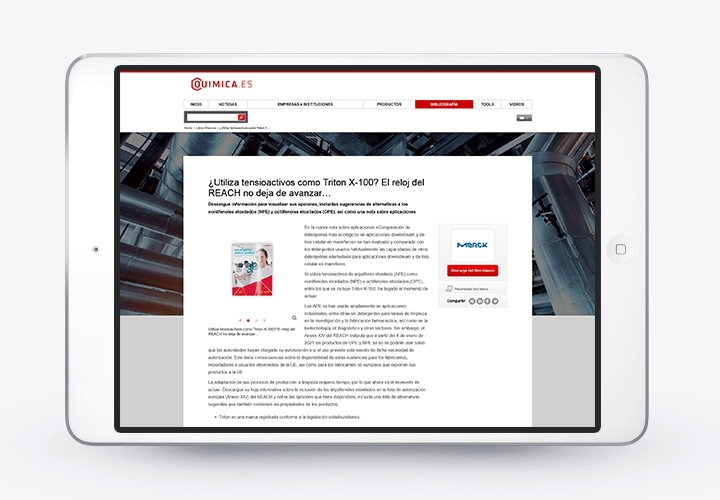
By describing the content in multiple languages, you’ll allow users from all over the world to find your whitepaper.
The bottom line: Multilingual content is key to gaining international customers
With each additional language on your website, you can increase your number of sales leads by a factor of 3 to 5. Nevertheless, almost 50% of the companies surveyed still don’t boost their sales this way.
By advertising on multilingual specialist portals, you can cost-effectively and reliably gain new customers from around the world.
If you’d like to find out what great possibilities and opportunities specialist portals offer for companies in the chemical, life sciences and food & beverage industries,
call us on
+ 49 30 / 965 368 451
or click here:

